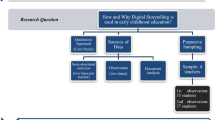Abstract
The rapid proliferation of story and game apps aimed at the early years has contributed to the iPad’s visibility as a device for family entertainment and informal education. It is often claimed that iPads and other touch screen devices place sophisticated media in the hands of users. Moreover some have argued that the iPad is particularly appealing for young children because of its weight, portability and intuitive touch-screen interface. This paper critically appraises these claims by a close analysis of young children (14-22 months) in two story-app sharing interactions with an adult. The data is drawn from a wider study based in early years settings in the North of England. An analytical focus based on the material affordances of the iPad and apps is developed and it is suggested that this is a fruitful approach to adopt. Not only does this approach highlight important issues for practitioners, but it also suggests that the interface, and the story-apps used, may not be quite as intuitive as has been suggested. The data also suggest that broader socio-cultural issues may emerge from this sort of data.
Similar content being viewed by others
References
Bannister, S. (2010). Integrating the iPod touch in K-12 education: Visions and vices. Computers in schools, 27(12), 121–131.
Burden, K., Hopkins, P., Male, T. & Trala, C. (2012). iPad Scotland evaluation. Hull: University of Hull. Retrieved from http://www2.hull.ac.uk/ifl/ipadresearchinschools.aspx
Burnett, C. & Merchant, G. (2012). Learning, literacies and new technologies: The current context and future possibilities. In J. Larson & J. Marsh (Eds.), The handbook of early literacy. (pp. 575–586). London: Sage.
Clark, H. (2003). Pointing and Placing. In S. Kitta (Ed.), Pointing: Where language, culture, and cognition meet. (pp. 243–268). Hillsadale NJ: Erlbaum.
Cohen, M., Hadley, M. & Frank, M. (2010). Young children, apps & iPad. New York: Michael Cohen Group. Retrieved from http://mcgrc.com/publications/publications/
Cope, B. & Kalantzis, M. (Eds.) (1999). Multiliteracies: Literacy learning and the design of social futures. London: Macmillan.
Davies, J. & Merchant, G. (2013). Digital literacy and teacher education. In P. Benson & A. Chik (Eds.), Popular culture, pedagogy and teacher education: International perspectives, (pp. 180–193). London: Routledge.
Flewitt, R., Nind, M. & Payler, J. (2009). ‘If she’s left with books she’ll just eat them’: Considering inclusive multimodal practices. Journal of Early Childhood Literacy, 9(2), 211–233.
Kendon, A. (2004). Gesture: Visible action as utterance. Cambridge: Cambridge University Press.
Kallinikos, J., Leonardi, P. & Nardi, B. (2012). The challenge of materiality: Origins, scope, and prospects. In P. Leonardi, B. Nardi & J. Kallinikos (Eds.), Materiality and organizing: Social interaction in a technological world. Oxford: Oxford University Press.
Kucirkova, N. Messer, D., Sheehy, K. & Flewitt, R. (2013). Sharing personalised stories on an iPads: A close look at parent-child interaction. Literacy, 47(3), 115–122.
McNeill, D. (Ed.) (2000). Language and gesture. Cambridge: Cambridge University Press.
Merchant, G. (2012). Mobile practices in everyday life: Popular digital literacies and schools revisited. British Journal of Educational Technology, 43 (5), 770–782.
Minogue, J. & Jones, M. (2006). Haptics in education: Exploring an untapped sensory modality. Review of Educational Research 76(3), 317–348.
Oksman, V. & Rautiainen, P. (2003). ‘Perhaps it is a body part’: How the mobile phone became an organic part of the everyday lives of Finnish children and teenagers. In J.E. Katz (Ed.), Machines that become us: The social context of personal communication technology, (pp. 293–311) Transaction: New Jersey.
Pegrum, M., Oakley, G. & Faulkner, R. (2013). Schools going mobile: A study of the adoption of mobile handheld technologies in Western Australian independent schools. Australasian Journal of Educational Technology, 29(21), 66–81.
Rideout, V.J. & Hammel, E. (2006). The media family: Electronic media in the lives of infants, toddlers, preschoolers and their parents. Menlo Park, CA: Kaiser Family Foundation.
Author information
Authors and Affiliations
Rights and permissions
About this article
Cite this article
Merchant, G. Keep taking the tablets: iPads, story apps and early literacy. AJLL 38, 3–11 (2015). https://doi.org/10.1007/BF03651950
Published:
Issue Date:
DOI: https://doi.org/10.1007/BF03651950




